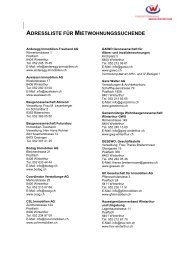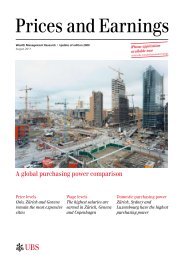Handbook for Investors. Business location in Switzerland.
Handbook for Investors. Business location in Switzerland.
Handbook for Investors. Business location in Switzerland.
You also want an ePaper? Increase the reach of your titles
YUMPU automatically turns print PDFs into web optimized ePapers that Google loves.
10.5.2 Taxable supplies<br />
VAT is levied on the follow<strong>in</strong>g types of services: 1. delivery of<br />
goods <strong>in</strong> <strong>Switzerland</strong> (<strong>in</strong>clud<strong>in</strong>g Liechtenste<strong>in</strong>); 2) supply of<br />
services <strong>in</strong> <strong>Switzerland</strong> (<strong>in</strong>clud<strong>in</strong>g Liechtenste<strong>in</strong>); 3) purchase of<br />
services (and certa<strong>in</strong> goods deliveries <strong>in</strong> <strong>Switzerland</strong>) from enterprises<br />
with their registered office <strong>in</strong> another country if the value of<br />
goods or services exceeds CHF 10,000 per year; and 4) import of<br />
goods.<br />
Certa<strong>in</strong> services provided to <strong>for</strong>eign recipients (as well as the<br />
export of goods and the delivery of goods abroad) are not taxed<br />
or are zero-rated with full <strong>in</strong>put tax recovery. The delivery of<br />
goods <strong>for</strong> the purposes of VAT is not limited to goods deliveries<br />
as def<strong>in</strong>ed by Swiss commercial law. The VAT law provides <strong>for</strong><br />
a number of bus<strong>in</strong>ess transactions (such as the ma<strong>in</strong>tenance of<br />
mach<strong>in</strong>ery, rental or lease of goods, trade <strong>in</strong> electricity, etc.) that<br />
are deemed to be supplies of goods <strong>for</strong> VAT purposes.<br />
10.5.3 Taxable amount<br />
The basis <strong>for</strong> the calculation of the taxable amount <strong>for</strong> the supply<br />
of goods and services is the agreed upon or the collected gross<br />
remuneration (<strong>in</strong> cash or <strong>in</strong> k<strong>in</strong>d). Input tax, i.e., the tax paid on<br />
purchases of goods and services, can be deducted. Consequently,<br />
only the value added is taxed (net all-phase pr<strong>in</strong>ciple).<br />
10.5.4 Tax rates<br />
The standard rate is 7.6 % (8 % from January 1, 2011) on every<br />
taxable supply of goods or services. A reduced rate of 3.6 %<br />
(3.8 % from January 1, 2011) is applicable to accommodations.<br />
A reduced rate of 2.4 % (2.5 % from January 1, 2011) applies to<br />
certa<strong>in</strong> categories of goods and services <strong>for</strong> certa<strong>in</strong> basic needs<br />
such as water supply, food and non-alcoholic beverages, cattle,<br />
poultry, fish, cereals and gra<strong>in</strong>, books and newspapers, services<br />
of non-commercial radio and TV broadcasters, etc.<br />
The Federal Tax Adm<strong>in</strong>istration offers further simplified VAT<br />
account<strong>in</strong>g <strong>for</strong> small bus<strong>in</strong>esses with turnover of below CHF 5<br />
million and a tax liability of CHF 100,000 or less per year. These<br />
small bus<strong>in</strong>esses may opt to submit VAT based on a balanced<br />
tax rate which is lower than the standard rate of 7.6 %, if they, <strong>in</strong><br />
return, waive the standard procedure <strong>for</strong> <strong>in</strong>put VAT account<strong>in</strong>g,<br />
which would otherwise be deducted from the VAT levied on turnover<br />
(<strong>in</strong>put VAT deduction). This simplified taxation method must<br />
be ma<strong>in</strong>ta<strong>in</strong>ed <strong>for</strong> at least one year, and VAT returns need to be<br />
filed twice a year only – <strong>in</strong> contrast to the standard declarations<br />
filed quarterly.<br />
10.5.5 Exemptions<br />
The law differentiates between VAT-exempt and VAT-excluded<br />
turnover from VAT. No VAT is levied <strong>in</strong> either case, but a dist<strong>in</strong>ction<br />
is made regard<strong>in</strong>g the <strong>in</strong>put VAT deduction.<br />
In cases of exclusions, there is no <strong>in</strong>put tax deduction possible<br />
<strong>for</strong> the taxes paid <strong>in</strong> generat<strong>in</strong>g the turnover excluded from VAT.<br />
Excluded activities are the healthcare sector, education, culture,<br />
sport, social care, most bank<strong>in</strong>g and <strong>in</strong>surance activities, rental<br />
and sale of real estate, as well as gambl<strong>in</strong>g and lotteries. For<br />
most of these categories, however, the taxpayer may opt <strong>for</strong><br />
taxation voluntarily, except <strong>in</strong> the case of bank<strong>in</strong>g and <strong>in</strong>surance<br />
turnover.<br />
In contrast to activities excluded from VAT, exempt activities allow<br />
<strong>for</strong> an <strong>in</strong>put VAT deduction <strong>for</strong> all taxes paid <strong>in</strong> generat<strong>in</strong>g the<br />
turnover <strong>in</strong> question (true exemption). An example of an activity<br />
exempt from tax is the export of goods (see also section 10.5.7).<br />
<strong>Bus<strong>in</strong>ess</strong> activities abroad are not subject to VAT. These types of<br />
turnover are generally the result of <strong>in</strong>ternational bus<strong>in</strong>ess models.<br />
A typical example is a Swiss trad<strong>in</strong>g company that buys products<br />
from a <strong>for</strong>eign manufactur<strong>in</strong>g company and sells them to customers<br />
<strong>in</strong> a third country, shipp<strong>in</strong>g the products directly to those<br />
customers. Activities <strong>in</strong>volv<strong>in</strong>g the supply of goods or services<br />
abroad entitle the taxpayer to deduct <strong>in</strong>put tax, provided the<br />
turnover does not qualify as excluded turnover.<br />
10.5.6 Deduction of <strong>in</strong>put taxes<br />
An enterprise registered <strong>for</strong> VAT is liable <strong>for</strong> VAT on all supplies<br />
(output tax) and will <strong>in</strong>cur VAT on purchases <strong>for</strong> the bus<strong>in</strong>ess<br />
(<strong>in</strong>put tax). In most cases, <strong>in</strong>put taxes may be deducted from the<br />
amount of output taxes due and so do not generally represent<br />
an additional burden <strong>for</strong> a bus<strong>in</strong>ess. VAT is a genu<strong>in</strong>e expense<br />
only <strong>for</strong> the end-consumer or <strong>for</strong> a bus<strong>in</strong>ess <strong>in</strong>volved <strong>in</strong> transactions<br />
<strong>for</strong> which no <strong>in</strong>put tax can be recovered (bus<strong>in</strong>esses with<br />
excluded <strong>in</strong>come such as banks and <strong>in</strong>surance companies).<br />
98 <strong>Handbook</strong> <strong>for</strong> <strong>Investors</strong> 2010









